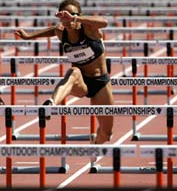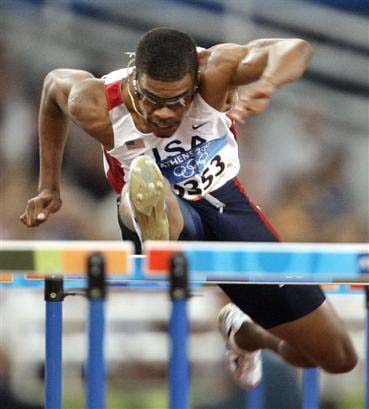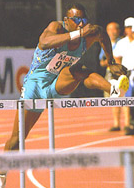This article will be a quick one, based on an observation I’ve made over the past few months of watching hurdlers in practice and in indoor meets. While the idea that one must stay relaxed while sprinting and hurdling is nothing new, it usually isn’t very helpful to tell an athlete to “stay relaxed.” The key is to pinpoint where tension manifests itself, and to provide the athlete with cues that will remind him or her to stay relaxed. In hurdling, it seems to me, tension reveals itself mostly in the shoulders.
There are a number of things you want to take place during take-off into the hurdle, but raising the shoulders isn’t one of them. You want the knee to drive at the crossbar, the lead arm to drive upward with the elbow bent, the trail arm to pull back so that the hand is touching the hip, and the chest to push down over the thigh of the lead leg, helping to generate forward propulsion over the barrier. Unfortunately, many hurdlers do also raise their shoulders during take-off. It’s another one of those bad habits that, if it isn’t identified and addressed early on, can be very difficult to correct later in the athlete’s career.
The problem with raising the shoulders is that it excessively raises the center of gravity. And the whole point of hurdling is to clear the crossbar while raising the center of gravity as little as possible. When you raise the center of gravity, you increase air time, and the last thing in the whole wide world you ever want to do as a hurdler is increase air time.


The photo on the left is of Joanna Hayes, and the one on the right is of Terrence Trammell. Both hurdlers
have a style that I would consider less than efficient. Both raise the shoulder of the lead arm too high.
With Hayes, the arm is going across her body, causing the trail arm to flair out widely. With Trammell, the
elbow of the lead arm is above the hand. Hurdlers like Hayes and Trammell can get away with such flaws
because of their extreme speed, and, in the case of Trammell, power. And also because the other aspects of
their technique are solid.
In addition to increasing air time, the lead arm in particular can also cause balance issues when the shoulder raises too high. It can cause a tilt of the hips to the lead-leg side of the lane, which will lead to a stumble step upon landing. For the lead arm, the elbow should never be higher than the hand, and the hand should never rise above the head. Relax the shoulders, keep them low, and let the arms do the work – in a fluid motion that deviates as little as possible from the arm carriage employed during the sprinting strides. Raising the shoulders is an unnecessary power move. It works for power hurdlers, but don’t assume that because it works for a Terrence Trammell or a David Oliver that it’s going to work for you. You can generate the same amount of force with the arms, without raising the shoulders. So you’ll get the same results with less effort, and you’ll have a better of chance of being able to maintain your technique throughout the whole race.
To me, the most fluid hurdler ever in regards to arm carriage and keeping the shoulders low was Jack Pierce, who finished second to Greg Foster in a photo finish in the 1991 World Championships. Pierce never reached the legendary status of some of his rivals (Foster, Roger Kingdom, Colin Jackson), but he arguably had the best technique of any of them.


In these two photos, American Jack Pierce demonstrates the relaxed, fluid, yet forceful arm
carriage that makes for very efficient hurdling. Notice that his shoulders are not rising or
tensing, and his lead arm, in the photo on the right, is only as high as his nose.
If you’re a hurdler who has developed the habit of lifting the shoulders too high during take-off, the best way to fix this problem is the same way you’d want to go about fixing any technical problem: set up at least five hurdles and go at them slowly, focusing only on that one aspect of technique. The faster you run, the less your mind has time to think. And the mind needs time to think when it’s learning something new.
© 2007 Steve McGill
